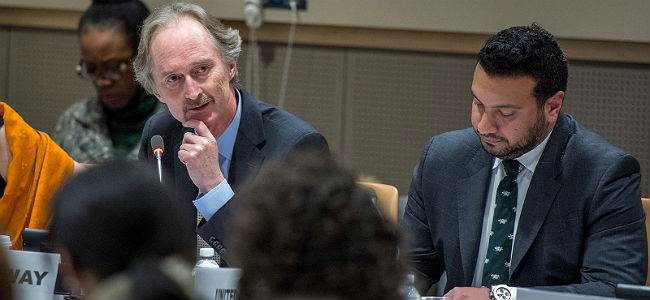Thank you, Princess Sarah,
It is an honor to co-invite to this panel discussion together with the UAE and Every Woman Every Child Everywhere. I know this is a subject close to your hearts, as it is to mine.
Indeed, our common idea when we embarked on this panel series, was to bring experts together to shed light on the particular health needs and challenges of women, children and adolescents that are directly affected by conflicts or natural disasters.
Today we are facing tremendous humanitarian challenges. More than 130 million people are in need of humanitarian assistance upon being forced to flee their homes. In these settings, women, children and adolescents are the most vulnerable.
The numbers say it all: 26 million women and girls of reproductive age are living in emergency situations. More than 60 % of maternal deaths take place in fragile settings. If we don’t address the needs of the most vulnerable groups we will not reach the SDGs.
The focus of today’s panel is an important one.
Urban areas are often the frontlines of the humanitarian response. More than 60 percent of all displaced persons end up in urban areas, among them large numbers of women, children and adolescents that are faced with dire humanitarian circumstances.
Cities can provide opportunities, shelter and security. But too often cities offer grim realities for vulnerable groups as hospitals, medical and health facilities and schools can be targeted by warring factions.
Adding to the challenge, many cities are rapidly growing. More than 50% of the world’s population now live in cities and more than a billion of these live in slums. By 2050 more than 75% of Earth’s population will live in cities. The influx of large numbers of displaced people into a city, places additional stress on cities’ infrastructure.
Today’s discussion takes place in the intersection between several important recent processes at the UN. For one, the SDGs in its goal 11, calls on us to ‘make cities and human settlements inclusive, safe, resilient and sustainable’.
The recently adopted New Urban Agenda, agreed at Habitat III, is another.
Habitat III frames how we can approach urbanization in the context of today’s challenges of climate change, pollution, migration etc., so we can address city planning and development in a sustainable way the next 20 years. We must make sure that urbanization creates cities of hope, not cities of despair.
Humanitarian response in urban areas and cities are complex.
We need strong urban contingency planning, which also Habitat III called for. This can set cities in a better position to prepare for future humanitarian situations. Humanitarian operations in urban settings are also relatively new for many humanitarian agencies. They need robust assessments in order to program effectively.
Understanding complex, urban communities can be challenging. Strong local government leadership in cooperation with partners in humanitarian aid and programming, is vital.
New technologies and registration services will also be key to identify the persons in need and victims of crisis in order to follow up in a targeted manner with access to quality health services. Displaced persons and refugees must be given access to health care and services where these are available.
Finally, being aware that acute humanitarian situations often ends up as protracted emergencies calls on all of us to improve on planning and delivery of services.
Humanitarian operations must make sure to support health and education services to refugee populations in order to avoid disrupting delivery of these services to the local population and in order to provide opportunities for the displaced. The services must be made sensitive to language and customs in order to avoid inter-communal confrontation and division.
We need to think holistically to respond to these challenges. Only a strong UN can lead on this demanding, cross-sectorial agenda in close cooperation with a broad set of partners.
I am looking forward to hearing the discussion and insights of our panelists today.
And without further a due, it is my honor to give the word to my dear colleague from the UAE, His Excellency Jamal Musharakh, as the next speaker.
And after that, I look forward to hearing from my friend Dr. David Nabarro, the UN Secretary General’s Special Adviser on the 2030 Agenda for Sustainable Development and Climate Change.
Thank you very much.
